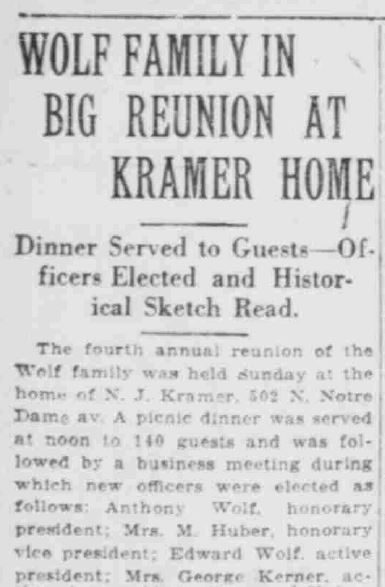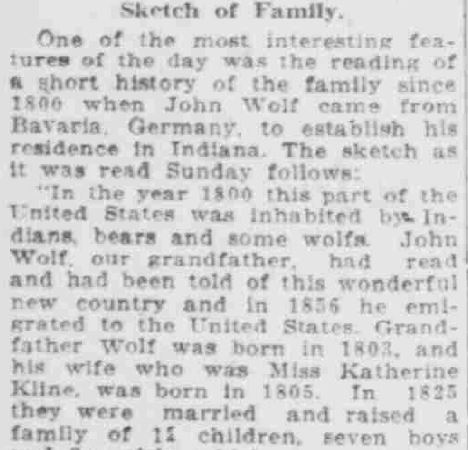“The aroma of woodchuck scalps, crow heads and wolf scalps will not be diffused throughout the sacred precincts of the Putnam County temple of justice, and of the office of the auditor, in particular. That will pertain to the year 1941, at least.”
So begins an article in the Greencastle Daily Banner, September 11, 1940.
In a meeting that week, Putnam County commissioners finally eliminated payment in cash for the hides of animals deemed “pests of economic life.” On the eve of World War II, this legal relic of pioneer days was still lingering around in the statute books.
In recent years, the expenditure on such bounties has not amounted to much, but the bounty offer was still in effect and occasionally some claimant for such payments would go to the auditor’s office to file claims for payments, and would bring along tangible proof. Out of which arose the odor.
The statutes of Indiana in 1875 [it was actually much earlier than this] provided that county commissioners “may” offer a bounty of $20 for wolf scalps, with a $3 bounty of wolves under 6 months of age; also, $5 for each fox scalp; or $1.50 when under 6 months. A year or two ago, Putnam County commissioners were called upon to pay a bounty for a wolf scalp.
In a later law, a bounty was provided for wood chuck (or ground hog) scalps, and owl or hawk heads, but with screech owls and sparrow hawks excepted. That was in the year 1883.
In 1911, crow heads and eggs were added to the list of outlaws, and a bounty was provided of 10 cents for each crow head and 5 cents for each crow egg, the eggs to be in lots of 10 or more.
(American hunters with wolf hides, Northern Rockies, circa 1920.)
In 2011, no less a paper than The New York Times reported on Terre Haute’s recurring crow problem — a major ornithological nightmare that migrated down to Bloomington early in 2015. For months, urban crows left the Monroe County courthouse, downtown parking meters, and city sidewalks soaked in bird droppings. Surely this was avian revenge for the county commissioner’s bounties placed against their ancestors?
The interesting story of animal bounties goes back deep into Indiana history — as do the wolf terror tales that go along with it.
When Indiana became a state just two-hundred years ago, the area bounded by the Ohio River, Lake Michigan, and the Illinois prairies was one of the wildest spots on earth, full of buffalo, black bears, and cougars. (Abraham Lincoln wrote a ballad about a bear hunt.) Old-growth timber could still be found in most Hoosier counties at the time of the Civil War. Though fur-bearing animals had been the main lure for French explorers, one of the French nuns who founded St. Mary-of-the-Woods in the 1840s wrote that “wood is commoner than dust.” In northwest Indiana, parts of the Kankakee Swamp — formerly one of the biggest wetlands in North America — weren’t drained until the 1920s. Modern agriculture in some northern Indiana townships is less than a hundred years old.
At the start of the Jazz Age, the Kankakee’s ancient but dying wilderness was still a hideout for wolves. In 1918, the Lake County Times reminded readers about their fanged and rarely-seen neighbors on the far outskirts of Chicagoland. Gray wolves, Canada lynxes and possibly even massive timber wolves also occasionally migrated down from the wilder parts of northern Michigan. While these creatures tried to avoid human beings, swamp fires sometimes drove them out onto the farms encroaching on the ragged edge of the marshland.

The bounty on hides that Putnam County eliminated in 1940 originated in pioneer days, when Hoosiers could actually pay their taxes with animal hides. Meant to encourage the war on the wilderness, bounties figured into state budgets as early as 1817. State funds forked out in exchange for this “public service” sometimes amounted to more than the dollar amount spent on road improvements, presidential elections, the state prison — and even our own State Library:
(Indiana Palladium, December 21, 1833.)
The Indiana State Sentinel carried one colorful story in 1881 — entitled “Early Times” — about how wolf scalps were used literally as dollar bills. Signed “M.F.H.,” the author recalled a conversation with a man in Columbus, Indiana, a Kentuckian who — if the date of his birth is correct — would have been 102 years old at the time this story was printed. The frontiersman, who came north in 1826, once served as Bartholomew County treasurer:
 (“Early Times,” Indiana State Sentinel, June 29, 1881.)
(“Early Times,” Indiana State Sentinel, June 29, 1881.)
By the early 1900s, the misunderstood canine specter peering out of Indiana’s diminishing forests and swamps was a rare sight — as were the mangled carcasses of farm animals that wolves were known to attack. Yet the morbid imagination spawned by European folklore was brought into play to defend farmer’s property, as the war on wolves continued unabated in the American West.
Hoosiers heard wolf tales stretching back hundreds of years — from the Grimm Brothers’ gory version of the old Black Forest tale Rotkäppchen (“Little Red Riding Hood,” later bowdlerized and Disneyfied for delicate audiences) to the quintessentially Russian tale of a pack of wolves that killed and ate a wedding party traveling by sleigh at night. That story was told in the pages of Willa Cather’s great novel My Ántonia (1918), set in Nebraska. In the early 1980s, Paul Schach of the University of Nebraska collected wolf stories brought to the Great Plains by German immigrants whose families had lived in Russia for a few generations before coming to America. Russian-German tales almost definitely inspired Cather’s miniature horror story in My Ántonia. Yet American newspapers were already carrying chilling wolf tales long before Cather’s novel.
(Edmund Spenser, “Nocturnal Battle with Wolves” in Russia, 1855. Most fatal wolf attacks still take place in the Caucasus and Central Asia. The words volk [male wolf] and volchitsa [female] cause a shiver in Russian spines yet.)
(“The Wolf of Ansbach” was a nightmarish creature said to have terrorized part of Germany in 1685, when it carried off and ate several children. Villagers believed it was either a werewolf or the reincarnation of their local burgomaster, “whose death had gone unlamented.” The animal was eventually driven into a well, killed, and dressed in human clothing — including a wig and mask — then hung on a gibbet. France’s Beast of Gévaudan, killed in 1767, was even scarier.)
In the winter of 1880, Willa Cather’s old Russian “wedding” story found an echo in Terre Haute’s Daily News, which printed a pioneer’s reminiscence entitled “A Night with Wolves.” The tale, told in first person, sounds like non-fiction but the dialogue is dramatized. Set around 1845, the hair-raising event took place one frozen, snowy night in the Upper Midwestern wilds a few miles outside the young town of Lansing, Michigan, where the author claimed that a hungry pack of wolves attacked a stagecoach he was traveling in by moonlight. As the terrified horses race away in a panic, dragging the coach and passengers behind them, the driver — his father — climbs out on the reins to cut part of his team loose, letting them drop as sacrificial victims to the bloodthirsty wilderness. With their flanks and throats ripped open by the wolves’ teeth, the horses collapse and are devoured, until one horse makes it into Lansing and spreads the news.
(Terre Haute Daily News, December 3, 1880. This story might have been true. Others were probably mythic. The “Benton County beast” was a mysterious “lioness excitement” that occurred near the Kankakee Marsh back in 1874.)
Long, scary and possibly fictional stories like these became rare over the years. Bears are usually the protagonist now, as in Jon Krakauer’s Into the Wild. But even today, headlines still announce occasional sightings of and attacks by potentially dangerous animals in the rural Midwest. Early 20th-century readers encountered plenty of these headlines.
In October 1922, seven wild wolves were reported attacking livestock on a farm near Warsaw, Indiana. Farmers there were scared enough to keep their children away from school for a few days.
 (South Bend News-Times, October 24, 1922.)
(South Bend News-Times, October 24, 1922.)
(U.S. Army officers hunting a wolf on the ice of the Upper Mississippi River, 1843. The story was that the clever wolf would race toward an air hole in the ice, spin around quickly, and leave the hounds to fall in. American Turf Register and Sporting Magazine.)
Tall tales often bleed over into news reportage. But fact and fiction can be hard to separate. In 1920, the South Bend paper carried the story of one Kansas farmer’s desperate battle with three wolves trying to break into his farmhouse.
 (South Bend News-Times, March 31, 1920.)
(South Bend News-Times, March 31, 1920.)
Horace E. Jackson, “a wealthy Chicago board of trade broker,” was allegedly stalked by “skulking wolves” in Minnesota’s North Woods in 1916, though exposure to the cold was an even bigger danger.
Fear-mongering news stories about wolves were partly discredited by a writer — possibly a naturalist — in the Greencastle Herald in 1913. Wolves, he reminded readers, usually fear men more than men fear them.
 (Greencastle Herald, June 7, 1913.)
(Greencastle Herald, June 7, 1913.)
 (Greencastle Herald, March 17, 1922.)
(Greencastle Herald, March 17, 1922.)
The Indiana DNR still gets plenty of crazy phone calls about unusual animal sightings. One recent report that turned out to be true was the migratory mountain lion that was stalking parts of Greene County near Bloomfield in 2010 and has also been reported near Brazil, Greencastle, and Bloomington. The lion was photographed by one of the DNR’s motion-sensitive cameras and was originally thought to have been a tiger escaped from the Exotic Feline Rescue Center in nearby Center Point, Indiana.
What the DNR shouldn’t take seriously is any reports about the Wolf family, who once lived on Notre Dame Avenue in South Bend. This 1920 headline sounds like another one of those grisly folktales.









